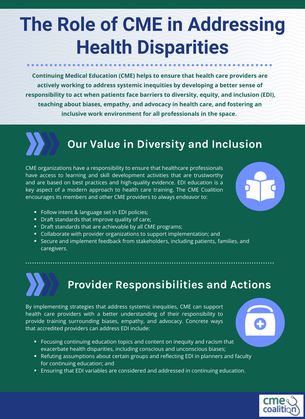Health Disparities
|
Continuing Medical Education holds a special obligation, and plays a vital role, in advancing solutions to address disparities in health care that are experienced by socially disadvantaged populations as defined by their race, ethnicity, gender, education, income, disability, geographic location, or sexual orientation.
The members of the CME Coalition embrace the challenges inherent in tackling these issues and call on participants and stakeholders in Continuing Medical Education to commit to honestly acknowledging past and present biases in medical education and strive towards a more diverse, inclusive, and fair health care ecosystem. |
The Role of CME in Addressing Health Disparities
Continuing Medical Education (CME) helps to ensure that health care providers are actively working to address systemic inequities by developing a better sense of responsibility to act when patients face barriers to Diversity, Equity and Inclusion (EDI), teaching about biases, empathy, and advocacy in health care, and fostering an inclusive work environment for all professionals in the space.
Health disparities, by definition, are preventable differences in the burden of disease, injury, violence, or opportunities to achieve optimal health that are experienced by socially disadvantaged populations. Specifically, socially disadvantaged populations encompass: (1) race or ethnicity; (2) gender; (3) education or income level; (4) disability; (5) geographic location; or (6) sexual orientation.
CME organizations have a responsibility to ensure that health care professionals have access to learning and skill development activities that are trustworthy and based on best practices and high-quality evidence. EDI education is a key aspect of a modern approach to health care training. The CME Coalition encourages its members and other CME providers to always endeavor to:
Health disparities, by definition, are preventable differences in the burden of disease, injury, violence, or opportunities to achieve optimal health that are experienced by socially disadvantaged populations. Specifically, socially disadvantaged populations encompass: (1) race or ethnicity; (2) gender; (3) education or income level; (4) disability; (5) geographic location; or (6) sexual orientation.
CME organizations have a responsibility to ensure that health care professionals have access to learning and skill development activities that are trustworthy and based on best practices and high-quality evidence. EDI education is a key aspect of a modern approach to health care training. The CME Coalition encourages its members and other CME providers to always endeavor to:
- Follow intent & language set in EDI policies;
- Develop standards that improve quality of care;
- Develop standards that are achievable by all CME programs;
- Collaborate with other stakeholders to support implementation; and
- Secure and implement feedback from stakeholders, including patients, families, and caregivers.
health care Providers' Responsibilities
By implementing strategies that address systemic inequities, CME can support health care providers with a better understanding of their responsibility to provide training surrounding biases, empathy, and advocacy. Concrete ways that accredited providers can address EDI include:
- Focusing continuing education topics and content on inequity and racism that exacerbate health disparities, including conscious and unconscious biases;
- Refuting assumptions about certain groups and reflecting EDI in planners and faculty for continuing education — including patients, families, and other public representatives; and
- Ensuring that EDI variables such as social factors, identity, intersectionality, affordability and access of recommended treatment, and cultural and linguistic competency are considered and addressed in continuing education.
state requirementsThe following states have implemented laws which require that providers — and other specified entities in certain circumstances — take part in CME courses related to EDI: The links above provide a brief overview of the requirements set forth by each respective state. As state legislatures begin to convene their forthcoming legislative sessions, the CME Coalition expects to see more legislation on the subject. |
Key resourcesThe following resources are available to those interested in additional information about promoting EDI in CME:
|
LESSON PLANSLesson plans on EDI could include:
|
WHAT OUR MEMBERS ARE DOING
Members of the CME Coalition have taken strides to provide physicians and other health entities with information on health EDI.

Health inequity is a serious public health issue and the COVID-19 pandemic has highlighted important racial and ethnic differences in health care. In response to these differences, CME Coalition Member Pri-Med launched Bridging the Gap: Conversations with Dr. Hall, a monthly live web series hosted by primary care clinician and expert in African American health care, Dr. Gregory Hall in July 2020. Each episode focuses on a different aspect of African American health in order to improve patient outcomes, with topics ranging from cancer screening to hypertension to vaccine hesitancy and more. Feedback from learners has been overwhelmingly positive and Pri-Med is looking forward to continued education on this topic. For more information click here.

The State Medical Society COVID-19 Collaborative began in late March 2020 to assist state medical societies in addressing the COVID-19 public health emergency. Speakers have included representatives from over 40 organizations, including the Food and Drug Administration (FDA), Department of Veterans Affairs (VA), Indian Health Service, Department of Health and Human Services (HHS), Google, and Federation of State Medical Boards. Industry speakers have included Pfizer, Moderna, Eli Lilly, Regeneron, and Phillips. Participants of the collaborative have included over 40 state medical societies and have hosted over 90 accredited webinars and online courses on COVID-related issues.

The California Medical Association presented to a combined group of CME stakeholders on their recently released draft CME standards on Implicit Bias and Cultural and Linguistic Competency following the passage of California's new law, which requires CME activities in California to include education on cultural and linguistic competency and implicit bias.

Addressing Unconscious Bias and Disparities in Healthcare is a nationwide initiative to provide clinicians with education and actionable steps to improve health outcomes among all patients, including underserved and marginalized populations. This CME Outfitters (CMEO) initiative is supported by an educational grant from the Johnson & Johnson Institute and the Johnson & Johnson Family of Companies as part of CMEO’s commitment to invest in and promote health equity solutions. All educational activities are hosted on CMEOutfitters.com and offer CME/CE credit for three years. Clinicians who participate in three or more activities will receive a digital badge in recognition of their education in addressing unconscious bias and racial disparities. CMEO's Diversity & Inclusion Hub serves as a launch pad to an array of jointly accredited CE addressing health disparities in dermatology, gastroenterology/immunology (IBD), cardiology, infectious diseases (HIV), maternal health, oral health, pain care, and surgery.

The American Association for Cancer Research (AACR) published a Cancer Disparities Progress Report in 2020 with the overarching goal of increasing public understanding of cancer health disparities and of the importance of cancer health disparities research to saving lives. Additionally, AACR holds a conference each year — the Cancer Health Disparities Conference — on the science of cancer health disparities in racial and ethnic minorities and the medically underserved.



